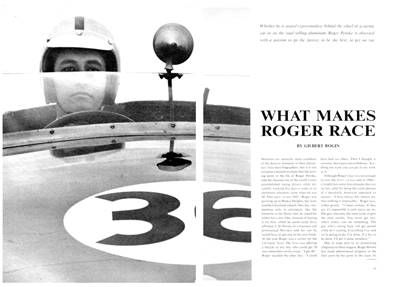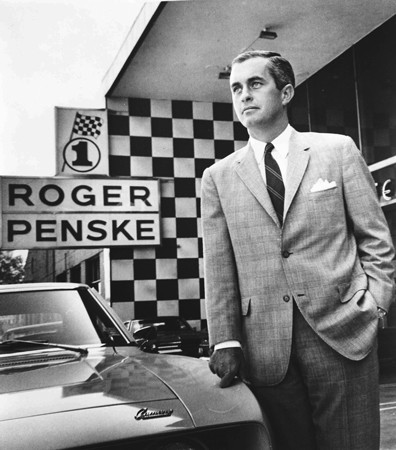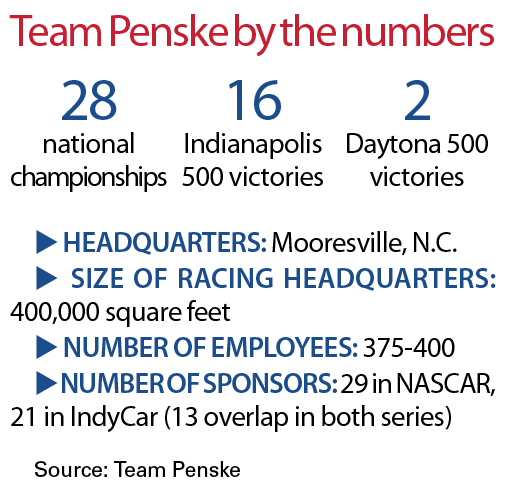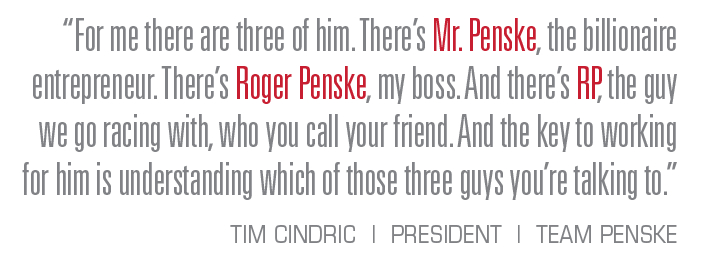"Whether he is seated expressionless behind the wheel of a racing car or on the road selling aluminum, Roger Penske is obsessed with a passion to go the fastest, to be the best, to get on top."
Spanning 14 pages at the back of a 1963 issue of Sports Illustrated, the profile of the young sports car driver began with that sentence.
It echoes still.
Penske was without peer among U.S. sports car drivers at the time, the defending North American champion, winning a record $34,350 the prior year, the equivalent of about $270,000 today. Yet he did not believe racing sports cars was a reliable way to earn a living with a wife and two young sons at home. So Penske maintained a day job, selling sheets of Alcoa aluminum, much of it to chicken farmers in Pennsylvania’s Lehigh Valley.
In the SI story, Penske, then 26, spoke candidly about his drive to build a successful business career, as well as his awareness that squealing the tires of a hot rod around a hillside bend might be at odds with that goal.
“In 15 years I want to be very, very successful in business, because I think I will have wasted my life if I haven’t
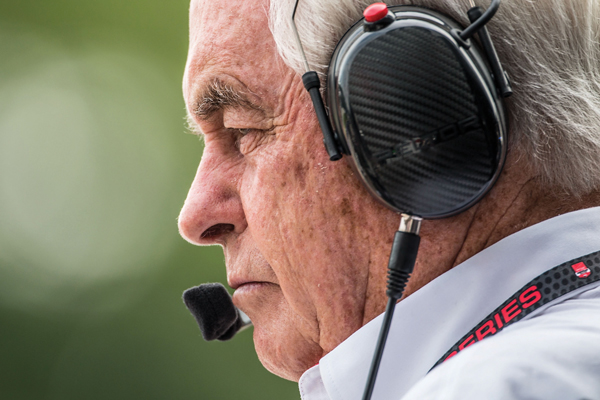 |
Roger Penske, featured in a 1963 Sports Illustrated article while still a sports car driver (below), used a race team to spread his name, that team’s success to build a brand, and that brand to build an empire.
Photo by: Getty Images |
been,” Penske said at the time. “I’m trying to maintain an image as a businessman, a responsible person. Racing, in this sense, is hurting me. I don’t want to be known as a race driver. I’ll be selling aluminum long after I’m through racing. I could just say I’ll go on racing, but you become a has-been, you turn into a jerk. But racing’s enabled me to meet people you got to know, to have contacts.”
In a small meeting room at the Conrad Hotel in Miami late last year, on the morning after NASCAR’s season-ending Sprint Cup race at Homestead, Penske listened as a visitor read back his words from that interview of a half-century ago, which today sound eerily prescient.
Penske did, in fact, walk away from race car driving. A few months after that SI interview, a friend offered him a job running a Chevrolet dealership in West Philadelphia. Not only did it pay $2,000 a month — a stout increase over the $425 a month he made hustling aluminum — it came with an option to buy the store in three years if he could come up with the cash.
To do it, he’d have to take a bank loan. He’d also have to carry insurance, which would be prohibitively expensive if he continued to race cars.
So Roger Penske hung up his driving helmet. But, aware that there was value in the fame racing brought him, he didn’t walk away from it entirely.
Late in 1965, less than a year after Penske closed on the dealership, the vice president of marketing at locally based Sun Oil Co. bought a Corvette from him. Penske chatted him up about the business benefits of racing, eventually selling Sunoco on a $2,500 deal to sponsor a car at the 24-hour endurance race in Daytona Beach, Fla.
The oil company backed him on the sports car circuit for the next couple of years, then in 1969 sponsored his first entry at the Indianapolis 500, which he would win just three years later with Mark Donohue driving.
As Penske had anticipated, racing begot business opportunities. Contact with manufacturers brought him car
dealerships — first one and then two and eventually more than 300, representing 40 brands. His truck leasing company grew from 330 vehicles to more than 300,000. A joint venture with General Motors to build heavy-duty diesel engines raced from 3 percent market share to 33 percent, and then went public. He took a speedway operation public at $15 a share and sold it for $45 a share three years later.
For decades, Penske has repeated the assessment that leading at the Indy 500 for more than 50 laps delivered the greatest ad value of anything he could buy, and that winning the fabled race — as he has 16 times — polished his brand as could nothing else.
Penske used a race team to spread his name, that team’s performance to build a brand, and that brand to build an empire.
Listening to his own declarations of a half-century earlier, he offered a light smile and nodded.
“I may have said it a little different way today, but I’d [stand by] the point I was making: That racing could open up doors for me,” said Penske, who built a dominant open-wheel team, an oft-envied NASCAR team, and a business empire that delivered personal wealth estimated to be about $1.5 billion.
“Look, obviously it worked. I can’t disguise that at all. For a long time everything they wrote about me said I was a race car driver. I didn’t want to be known as a race car driver. I said then that I wanted to be known as a businessman, and I meant it. I think today, people would say he’s a businessman who has a successful race team.
“That has taken me probably 50 years to do that.”
■ ■ ■
Penske sat in the front row of seats outside his suite above the start-finish line at Homestead-Miami Speedway, the president of his race teams, Tim Cindric, at his left; his wife, Kathy, to his right; longtime business confidant Walt Czarnecki next to her.
Clipped to the rail in front of him were a pair of scanners that fed the headset he wore from the dropping of the green flag to the waving of the checkered.
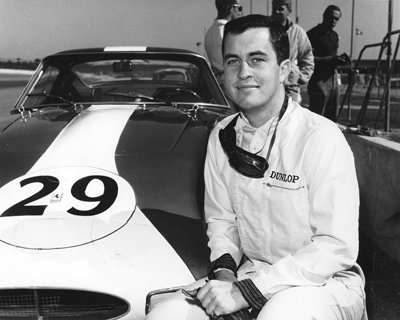 |
Shown at Daytona in 1963, Penske was named SCCA Driver of the Year in the early '60s, but retired from driving in 1965 to focus on business (below), starting with his first car dealership.
Photos by: Getty Images |
By its nature, this day was bound to carry an element of disappointment. Neither of Penske’s two drivers were alive in the race for NASCAR’s Sprint Cup championship, though both had strong seasons. The best they could hope for was a race victory that might salve the sting of their elimination.
For much of the race, it looked as if they might get it.
Between them, Joey Logano and Brad Keselowski led 158 of 267 laps, heading the field on the four longest runs of the day. Logano looked to have the best car but lost the lead after debris on the track brought out a caution with about 100 laps left. Keselowski was in front late in the race, leading all but one of laps 217 to 260, but then he, too, was bedeviled by a caution for debris, allowing season champion Kyle Busch to take the lead and then win.
To watch Penske during both of those key moments offered a window into the cool for which he is known. When NASCAR threw the yellow with Logano ahead, his chin dropped. He turned his head to Cindric, sharing a knowing but unspoken, “Can you believe it?”
When the same thing happened to Keselowski, Penske was less reserved. He rose from his seat, arms out and palms up, turning to the guests in his suite who shared his frustration.
But that was it. There was no eruption. He didn’t excoriate NASCAR, which with that last caution set the stage for the best finish it could hope for, with the top two cars in the point standings racing for the win.
As the race ended, Penske took to the radio to compliment both drivers and their crews on their performance, took off his headset, said a few quick, cordial goodbyes and headed for the elevator with his wife, Cindric and Czarnecki.
“Roger has one of the great poker faces of all time,” said Czarnecki, vice chairman of Team Penske, who met
Penske in the late ’60s and went to work for him in 1971. “He’s able to control his emotions. Even though on the inside he may be feeling 180 degrees from what his external appearance shows, you won’t see it. He’s always congenial and gracious.
“Perhaps I know him a little better than a lot of people, so I knew what was on his mind. But you won’t see him pounding the table. You won’t see him screaming. That’s just not what Roger Penske does.”
That even was the case a few weeks earlier, Cindric said, when Matt Kenseth intentionally wrecked Logano, drastically reducing his chance at the championship.
“You bring it up now, and I admit it’s kind of in my craw,” Penske said on that Monday morning in Miami. “But, on the other hand, there’s nothing you can do about it. Nothing. And to create a lot of noise about it, it really is a negative. A disturbance. Something you don’t need to continue talking with your people about. You’re better off moving on.”
Speak with anyone who knows Penske well, and one of the first attributes they rattle off is this ability to “look through the front windshield,” as he likes to say, reflecting on the past only as a means to learn, insisting that those in his organization adopt that approach as their own.
That goes not only for putting disappointments behind him, but also for refusing to linger on success.
“One thing about Roger that I really admire, he is what his record says he is, and he doesn’t have to flaunt it,” said Rick Hendrick, a close friend who, like Penske, owns both an elite NASCAR team and one of the world’s larger auto chains. “He doesn’t have to brag. You don’t hear Roger talking about what he’s done in the past. That’s in the rearview mirror. He doesn’t dwell on what he’s accomplished. His mind is running so fast about how to get better, how to do more. He’s not the kind of guy to want to sit down and talk about all the trophies. His mind is so turbo-charged to what’s next. How do I make this better.”
Penske is known for loyalty to personnel and business partners. For a boundless work ethic, spread across many miles with little sleep. For attention to detail, and a passionate belief that it could yield the tenth of a second that would put his team ahead. For a willingness to sweep floors, plow snow or check the bathrooms of a camper to make sure no one snuck into his speedway without a ticket. For a right-or-wrong, black-or-white approach, especially on matters that cut to his character.
“He exudes leadership and professionalism and high performance in everything he does,” said NASCAR Chairman Brian France, who was in his teens when he met Penske and still counts him as a mentor. “And he does everything with huge integrity, even when it’s harder to do. He will not vary from that.”
■ ■ ■
Cindric grew up the son of an engine builder in Indianapolis, frequenting the speedway at which Penske has been so dominant that fans shout “Hail Caesar” when his golf cart passes by.
For as far back as he can remember, going back to grade school days in the 1970s, Cindric spent any spare time he had in May at the speedway, knocking around his father’s spot in the old wooden garages along Indy’s famed Gasoline Alley, at the end of the same row as the garages occupied by Team Penske. Children weren’t allowed in the garages, so Cindric had to sneak past security to get to his father’s area, where he’d lay low until the guards left at 6 p.m. Once they were gone, he had his run of Gasoline Alley, tooling around on a golf cart to collect souvenirs, including a treasured Pennzoil Z-7 hat from Penske’s star driver, Rick Mears.
When cars were on the track, Cindric would find a spot in the grandstands above Penske’s pit.
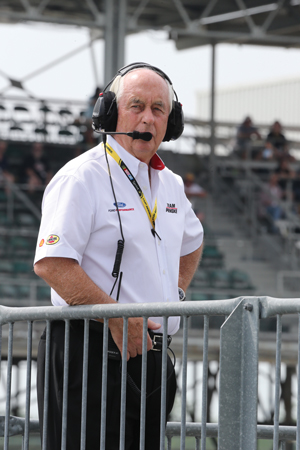 |
Through 50 years, Penske's success has been driven by a meticulous approach to detail, innovation, loyalty and work ethic.
Photo by: Jim Fluharty / NASCAR Illustrated |
“I’d sit there and just watch his team, because I thought that they were it,” Cindric said. On occasion, Cindric’s father, Carl, would be called upon to build an engine for one of Penske’s Indy entries. In 1971, he delivered a motor that put driver Mark Donohue on the front row, pleasing Penske so greatly that he surprised Carl Cindric with a bonus check, which he used to outfit the family’s new home with a stretch of orange shag carpet.
So revered was Penske in the Cindric household that as the family updated the house over time, they kept the carpet.
“When I moved out of the house after college, we still had that orange carpeting, even though there were bare spots,” Cindric said. “My father always said we can’t change the carpet because Roger Penske paid for it.”
For as long as he can remember, Cindric wanted to follow his father into racing as a mechanic. From the time he came out of college with an engineering degree, he hoped to put it to use working for Penske.
To Cindric, it seemed a lofty — and perhaps unattainable — goal, a secret ambition that he shared only with his wife, Megan, who like Cindric grew up around the Indy 500, the daughter of a team owner. She knew Penske well enough that when the couple would cross paths with him at an event or a restaurant, Penske always stopped to chat.
Cindric didn’t realize it, but Penske was watching his work with interest. When Cindric was team manager for Rahal Racing, Penske’s team borrowed cars from Rahal, scrambling for a second chance when its own machines were slow during qualifying in 1995. Though it would be the nadir of Penske’s racing experience — both cars failed to qualify, leaving him out of the 500 for the first time in his 26 years at the event — Penske was impressed by Cindric’s buttoned-down, organized approach, which in many ways matched his own.
When his team went winless in three of its next four seasons on the open-wheel circuit, Penske decided to reconsider every aspect of what they’d been doing. Convinced such an overhaul had to start at the top, he went looking for new leadership.
Late in the 1999 season, at about 10 p.m. on a Wednesday night, Penske surprised Cindric with a phone call.
Frustrated by 2 1/2 years without a win, Penske had decided it was time to either shut down his open-wheel team or reinvent it. He intended to change everything: drivers, cars, engines and tires. He also planned to install a president, something Team Penske had been without for 24 years, since the death of friend and driver Donohue during a Formula One practice. Penske wanted Cindric to meet him in New York to discuss the job.
At that meeting, they talked about the way the restructured team would operate. They also shared old stories.
Penske recalled that Cindric’s father had built him a terrific engine. Cindric told him about the carpet that the family could never replace.
Cindric took the job. In his first week, a check from Penske arrived in the mail, accompanied by a note:
“Get yourself some carpet.”
It wasn’t the last time Penske would surprise him with such a personal touch.
Until recently, the winning car owner at Indy received a trophy known in racing circles as the Flying Man. Cindric had one in his home, thanks to his wife, whose father won Indy as a car owner shortly before his death in 1986. She often teased him that her family had won the race but his hadn’t.
Cindric finally got his first taste of an Indy win in 2001, when he helped Penske break his drought. The next morning, when Penske was presented with his Flying Man, he turned and handed it to Cindric.
“For me there are three of him,” Cindric said. “There’s Mr. Penske, the billionaire entrepreneur. There’s Roger Penske, my boss. And there’s RP, the guy we go racing with, who you call your friend. And the key to working for him is understanding which of those three guys you’re talking to. That’s the best perspective I can give you on what it’s like to work for him.”
■ ■ ■
The night after his team ended its 2015 Sprint Cup season, Penske retired to the comfort of his 197-foot yacht Podium, docked in Miami. At 5:30 the next morning, he boarded a helicopter to visit a Porsche dealership soon to open in Fort Lauderdale.
Penske returned to Miami at 9:30 a.m. for a five-hour stretch of meetings at the Conrad, the bulk of them spent discussing the creation of a franchise system with NASCAR and its race team owners.
That Penske would have a race in Homestead on a Sunday night and an important NASCAR-related meeting at 9:30 the next morning in Miami, and still manage to wedge in a visit to a dealership, speaks to the pace at which he works, even at age 78.
“He can come right back from Tokyo and come straight to the track,” France said. “I can tell you, I go pretty fast.
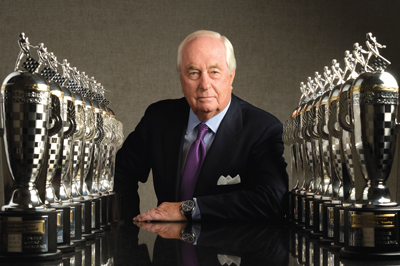 |
Flanked by his team's 16 Borg-Warner Trophies for its victories in the Indianapolis 500, Penske has become synonymous with success.
Photo by: Team Penske |
But I don’t come close to that sort of schedule. He’s in a different league.”
There is a work ethic that astonishes those 40 years his junior; a capacity to put in 16-hour days as he crisscrosses the globe, obsessively filling every last box of his schedule.
“We were together the other day, and he was leaving there and flying to Australia and then from Australia to Japan,” Hendrick said. “I told him, ‘You’re 10 or 12 years older than me. And if I tried to do that I’d be in bed for two weeks.’
“I don’t know how mentally and physically he has the capacity.”
Cindric likes to tell the story of the time Penske asked him to sit in for him on short notice at a dinner the next night with executives from Toyota. Cindric and Penske were in Chicago. The dinner was in Tokyo.
“Roger, I don’t even have a suit with me,” Cindric said.
“That’s OK,” Penske said. “You can go to the store and get whatever you need.”
“That’s just how he thinks,” Cindric said. “His concept of time and distance is very different from most of us. He’ll go to Tokyo and back for a dinner.”
When Penske was having a yacht built in Amsterdam, he traveled over a few times to check on it. Twice, he had Cindric go with him so they could go over race team matters on the plane.
“Hey, I’m going across,” Penske would tell him. “I’m going to pick you up on the way and we’ll meet about all this stuff. I’ll need a couple of hours in Amsterdam and then we’ll come back.”
Scott Atherton was in his first week on the job presiding over the speedway Penske owned in Fontana, Calif., when, unable to sleep because he still hadn’t adjusted to the time change, he headed to work about 3 a.m. one day. A couple of hours later, his phone rang.
“Yeah, Scott, it’s Roger,” said the voice on the other end of the line.
Penske was on his way back from Japan and planned to stop at the speedway later in the day. They were building new restrooms in the infield, and Penske wanted to decide on a tile pattern. He told Atherton to have one wall done with red tile 3 feet high, one done with red tile 4 feet high and one done with red tile 5 feet high. He’d be by later in the day to review the options.
“Sure enough, at 3 o’clock that afternoon, here comes Roger in the rental car, by himself,” said Atherton, who is now president of IMSA, the sports car sanctioning body. “We drive to the infield, where the restrooms are under final construction. We’ve got the tile made up. He says, ‘I’m thinking 5 feet is the way to go; what do you think?’ Of course — I’m no dummy — I said: ‘Five feet — absolutely!’ So he says, ‘Tear those other two down and rebuild them at 5 feet and we’re good to go.’ Hops back in his car, drives back to the airport and is on to his next stop.”
Almost 20 years later, Penske runs at that same pace, with no indication or plan of tapping the brakes.
“He has 13 grandkids and he has loved going to watch their hockey games, or when we take a little time off together in the summers,” said Greg Penske, the second of Penske’s five children, who has worked for his father on various ventures and now oversees his five auto dealerships in California. “But at the end of the day, he has always worked that way. It’s the way his DNA is, the way he was born. He wouldn’t want it any other way. He doesn’t want to stop. He still is as sharp as he’s ever been. Still asks the best questions of anyone. I don’t see that slowing down.
“I kidded him when he turned 75 and said, ‘You’ve got 25 left to go.’ By then there may be something that gets him to 125.”
More than a half-century has passed since Penske walked away from driving race cars in order to build a business. His hair has been snow white for so long, it has become his trademark, as much a part of Indy as the yard of bricks at the finish line.
Yet, at his core, little has changed.
Roger Penske is obsessed with a passion to go the fastest.
To be the best.
To get on top.
“I guess you might say racing has been my fishing trip and golf game on the weekend for all these years,” Penske said. “But I also saw it as a very instrumental and strategic tool to get access to many of the top automotive and transportation organizations worldwide. It’s amazing when you partner with someone like Mercedes and you win the Indianapolis 500 with their top people there.
“What that means in today’s world — you can’t buy it.”
Staff writer Adam Stern contributed to this report.
Quick Hits
NEATNESS MATTERS: Because of his job, Mike Nelson has no excuses to use if he makes a mess at home.
Nelson is vice president of operations for Team Penske, whose penchant for tidiness is among the most well-known idiosyncrasies in racing. Walk into the team’s race shop in Mooresville, N.C.: spotless. Glance at the team’s hauler as it rides down the interstate: fully polished. Arrive at the team’s hospitality unit at the track: perfectly put in place.
“This place really makes it hard at home sometimes — I’ve said that to several people,” said Nelson, who has been with the team for 17 years. “It sets the bar so high that it gets you in trouble at home sometimes with the expectations of putting things away and the cleanliness side of things.”
Nelson says the approach is simple: Clean up after yourself and leave things the way you found them.
“If one of our sponsors or fans were to come by and see a mess, and we look like we hadn’t taken a shower in three days, then that’s probably not representing the sport, fans or our sponsors in the right manner,” Nelson said.
— Adam Stern
FINDING THE WAY BACK TO FORD: At the NASCAR season finale at Homestead, where Ford was the race sponsor, Roger Penske made the pre-race rounds with executives from the manufacturer. It was seen as a coup when Penske returned to Ford three seasons ago after spending a decade racing Dodges. His was a Ford team when he launched full time in NASCAR in 1991.
He left for Dodge a dozen years later, but Ford executives kept at him over the years, prodding him to return.
“He’d always say the same thing: The time will come,” said Edsel Ford II, great-grandson of Henry Ford and a member of the Ford Motor Co. board. “We were happy to get him back over to Ford in NASCAR when Dodge got out. But, don’t forget, Roger uses Chevrolet engines in his Indy cars and he has a very strong relationship with General Motors. He is that unique man that, when he talks to Ford, he talks to Ford with his Ford hat on. And when he talks to Chevrolet about IndyCar, he wears a Chevrolet hat. And the twain shall not meet. He has that unique ability to do that.”
— Bill King
STANDING UP FOR DETROIT: In 2014, when Shell-Pennzoil was looking for a city to host its new Shell Eco Marathon social initiative themed around energy-efficient vehicles, Roger Penske didn’t hesitate to give a recommendation.
“He said, ‘We want this in Detroit. We need this in Detroit,’” said Heidi Massey-Bong, Shell’s senior business adviser of NASCAR sponsorship. “Detroit at the time was going through a lot, and you’re thinking, ‘This might be good for Detroit; I don’t know this is good for Shell.’”
In the end, however, Detroit won the event.
So why has Penske, a Shaker Heights, Ohio, native, shown such a commitment to revitalizing the Motor City over the years?
“He calls Detroit his backyard — and if you know Roger, you know he wants a safe, clean, immaculate backyard," said Bud Denker, executive vice president of Penske Corp. “He really views it as, ‘How Michigan goes starts in Detroit.’ And that hub has to be operating very properly. It has to be aligned, rotating well and not having any flat spots.”
— Adam Stern



